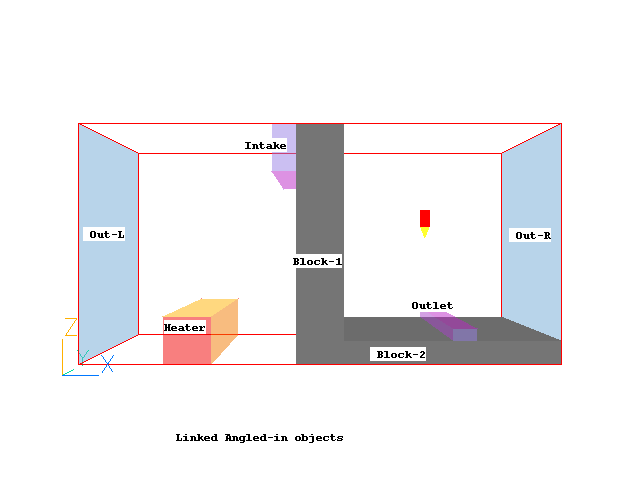
wherein:
This workshop example shows how two linked ANGLED-IN objects can be used to represent a duct that is not modeled.
The example is 2-dimensional. The fluid is air and the flow is turbulent and isothermal.
The geometry is to be as shown in the figure below, with the vertical dimension 1m and the horizontal dimension 2m :

wherein:
It will be assumed that there is a gain of heat and loss of scalar in the imaginary duct joining Outlet and Intake.
First activate the PHOENICS Satellite module in VR-Editor mode by either:
If you are uncertain of, or wish to change, your working directory, click on 'Options', 'Change working directory'.
When the Editor starts execution, what it shows on the screen will depend on what happens to be in your working directory. You can disregard this.
In order to make a fresh start;
You are now ready to begin.
Click on 'Main Menu' and set 'Linked Angled-In Objects' as the Title.
Click on 'Geometry'.
Change the X-Domain Size to 2.0 m and the Z-Domain Size to 1.0m.
Click 'OK' to close the Grid mesh settings dialog.
Click on 'Models'.
Leave the 'solution for velocities and pressure' ON, and turn the Energy Equation ON. Select Temperature as the form of the Energy equation. The default turbulence model, Chen-Kim KE (KECHEN), can be left active.
Click on 'Solution controls / Extra variables'. You may have to click on 'page dn' if this button is not visible near the bottom of the panel. In the SOLVE entry box, type C1 and then click on 'Apply'. You will see a new variable called C1. This will represent the mass fraction of contaminant.
The default solution procedure is 'Slabwise' which in this case means on each Z line. To solve C1 more efficiently change the N in the third row (labeled 'Whole-field') for C1 to Y. This will activate a whole-field solution which will solve for C1 over the entire domain in one go. Click on 'Previous Panel'.
Click on 'Top menu', then on 'OK' to exit the Main Menu.
The domain no longer fits the screen. To resize the view so that it does fit, click on the pull-down next to the 'R' icon on the toolbar then 'Fit to Window'.
Create the objects making up the scene
Click on the 'Object Management' button (O on the toolbar or
on the hand set). This will display a (currently empty apart from the domain) list of objects.
Create the Block-1 object:
In the Object management dialog, click on 'Object', 'New' 'New Object', 'Blockage'.
Change name to BLOCK-1
Click on 'Size' and set SIZE of object as:
Xsize: 0.2
Ysize: tick 'To end'
Zsize: tick 'To end'
Click on 'Place' and set Position of object as:
Xpos: 0.9
Ypos: 0.0
Zpos: 0.0
Click on 'General' and on 'OK' to close the Object Specification Dialogue Box. BLOCK-1 will now appear in the Object Management list of objects.
Create the BLOCK-2 object:
In the Object management dialog, click on 'Object', 'New' 'New Object', 'Blockage'.
Change name to BLOCK-2
Click on 'Size' and set SIZE of object as:
Xsize: tick 'To end'
Ysize: tick 'To end'
Zsize: 0.1
Click on 'Place' and set Position of object as:
Xpos: 1.1
Ypos: 0.0
Zpos: 0.0
Click on 'General' and on 'OK' to close the Object Specification Dialogue Box. BLOCK-2 will now appear in the Object Management list of objects.
Create the HEATER object:
In the Object management dialog, click on 'Object', 'New' 'New Object', 'Blockage'.
Change name to HEATER
Click on 'Size' and set SIZE of object as:
Xsize: 0.2
Ysize: tick 'To end'
Zsize: 0.2
Click on 'Place' and set Position of object as:
Xpos: 0.35
Ypos: 0.0
Zpos: 0.0
Click on 'General'.
Click 'Attributes'. Click Types and select 'Domain material'. This object will now be made of whatever material fills the domain (in this case air). It allows us to set heat sources.
Click Energy Source, and select 'Fixed heat Flux'. Enter 5000 in the Value box to set a heat source of 5000W for the entire object.
Click 'NONE' next to 'Source' for C1. Select 'Fixed value' from the list and click 'OK'.
Set the 'Value' to 1.0.
Click 'OK' to close the Object Specification Dialogue Box. HEATER will now appear in the Object Management list of objects.
Create the OUT-L object:
In the Object management dialog, click on 'Object', 'New' 'New Object', 'Outlet' and select the X plane for the outlet to lie in.
Change name to OUT-L .
Click on 'Size' and set SIZE of object as:
Xsize: 0
Ysize: 'To end'
Zsize: 'To end'
Click on 'Place' and set Position of object as:
Xpos: 0.0
Ypos: 0.0
Zpos: 0.0
Click on 'General'.
Click on 'Attributes'. Set the external turbulence to 'User set'. The default user-set external values give a turbulent viscosity which is roughly laminar. In many cases this is more stable than the 'In-cell' default setting which allows the external values to float.
Click on 'OK' to close the Object Specification Dialogue Box.
Create the OUT-R object:
In the Object management dialog, click on 'Object', 'New' 'New Object', 'Outlet' and select the X plane for the outlet to lie in.
Change name to OUT-R.
Click on 'Size' and set SIZE of object as:
Xsize: 0
Ysize: 'To end'
Zsize: 'To end'
Click on 'Place' and set Position of object as:
Xpos: 'At end'
Ypos: 0.0
Zpos: 0.1
Click on 'General'.
Click on 'Attributes'. Set the external turbulence to 'User set'. The default user-set external values give a turbulent viscosity which is roughly laminar. In many cases this is more stable than the 'In-cell' default setting which allows the external values to float.
Click on 'OK' to close the Object Specification Dialogue Box.
Create the INTAKE object:
Click on 'Object', 'New', 'New Object', 'Angled-in'.
Change name to INTAKE.
Click on 'Size' and set SIZE of object as:
Xsize: 0.2
Ysize: 'To end'
Zsize: 0.2
Click on 'Place' and set Position of object as:
Xpos: 0.8
Ypos: 0.0
Zpos: 'At end'
Click on 'General'.
Note that the shape and size of the angled-in object do not really matter - what matters is the size and shape of the area of intersection between it and any blockage which it overlaps. In this case the active inlet area will be the outer surface of the BLOCK-1 object which lies within INTAKE.
Click on 'Attributes' to set the inlet condition.
Enter 5.0 m/s for the velocity in the X-direction. This is pointing into the BLOCK-1 blockage and so will be treated as an extraction rate. In this case, the settings for temperature and turbulence do not matter, as it is the in-cell values which will be convected out. Click 'OK' to close the Attributes dialog.
Click on 'OK' to close the Object Specification Dialogue Box.
Create the OUTLET object:
Click on 'Object', 'New', 'New Object', 'Angled-in'.
Change name to OUTLET.
Click on 'Size' and set SIZE of object as:
Xsize: 0.1
Ysize: 'To end'
Zsize: 0.1
Click on 'Place' and set Position of object as:
Xpos: 1.55
Ypos: 0.0
Zpos: 0.05
Click on 'General'.
Note that the shape and size of the angled-in object do not really matter - what matters is the size and shape of the area of intersection between it and any blockage which it overlaps. In this case the active outlet area will be the outer surface of the BLOCK-2 object which lies within OUTLET.
Click on 'Attributes' to set the inlet condition. We want to link the outflow here to the inflow calculated for INTAKE. INTAKE is the preceding Angled-in in the list. Click on 'Link to other ANGLED-IN' until it states 'Previous'. Set the additional heat source to 1000W.
Click 'Additional source' for C1, and select '% Removal'. Click 'OK' then set the value to 50%. This means that only 50% of the C1 entering INTAKE will leave from OUTLET.
Click on 'OK' to close the Object Specification Dialogue Box.
Set the grid:
Click on the 'Mesh toggle' button. The default mesh will appear on the screen.
The orange lines are region lines,and denote the edges of the bounding boxes of each object. The blue lines are ordinary grid lines introduced by the auto-mesher.
Click anywhere on the image, and the 'Gridmesh settings' dialog box will appear.
The grid in all three directions is set to 'Auto'. This gives 65 cells in X and 49 in Z, and 1 cell in Y. This will suffice for the tutorial, though it might not be enough for a 'real' calculation. Click on 'OK' to close the dialog box. Click on 'Mesh toggle' again to turn off the mesh display.
Set the remaining solution-control parameters:
Click on 'Main Menu' and then on 'Numerics'.
The default number of iterations is 1000. This is more than enough to test if a model is set up correctly, but is rarely enough to obtain a converged solution.
Reset the total number of iterations to 500.
Click on 'Top menu' to return to the top menu.
Click on 'OK' to exit the Main Menu.
Setting the Probe Location
Before running the solver,it is a good idea to place the probe in a suitable place to monitor the convergence of the solution. Too close to an inlet, and the value will settle down very quickly before the rest of the solution. Placed in a recirculation zone, it may still show traces of change even though the bulk solution is converged. In this case, somewhere in the middle of the right-hand airspace is fine. This will let us see if any flow is getting through from the other side of BLOCK-1.
Click on the probe icon
on the toolbar or double-click the probe itself, and move the probe to X=1.5, Y=0.5, Z=0.5.
In the PHOENICS-VR environment, click on 'Run', 'Solver'(Earth), and click on 'OK' to confirm running Earth.
In the PHOENICS-VR environment, click on 'Run', 'Post processor',then GUI Post processor (VR Viewer) . Click 'OK' on the file names dialog to accept the default files.
To view:
To select the plotting variable:
To change the direction of the plotting plane, set the slice direction to X, Y or Z ![]()
To change the position of the plotting plane, move the probe using the probe position buttons
 .
.
Alternatively, click on the probe icon ![]() on the toolbar or double-click the probe itself to bring up the Probe
Location dialog.
on the toolbar or double-click the probe itself to bring up the Probe
Location dialog.
A typical vector and velocity plot from this case is:
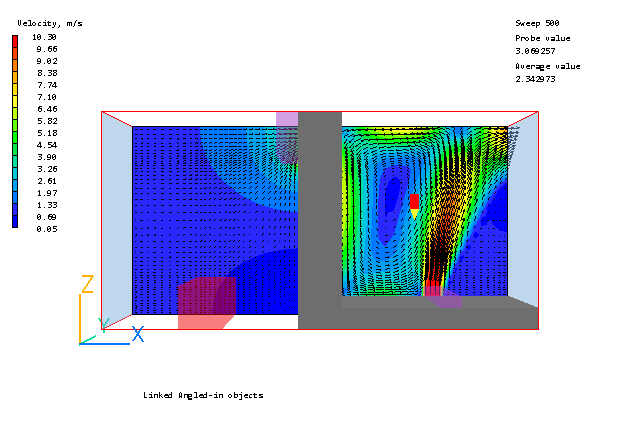
The velocity from OUTLET is 10m/s which is double the velocity at which INTAKE is sucking. This is correct, as the area of OUTLET is half that of INTAKE.
A typical Temperature contour plot is:
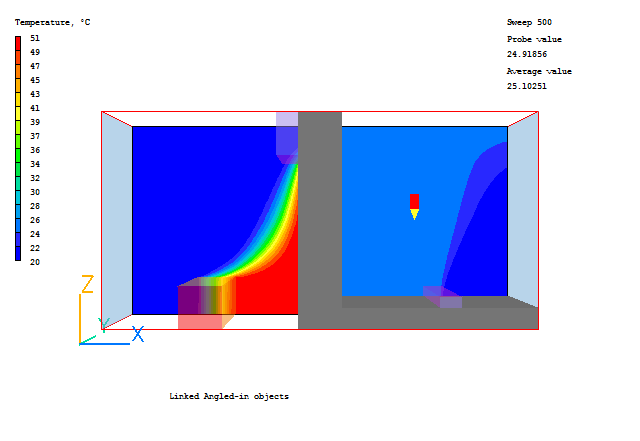
A typical Scalar Concentration contour plot is:
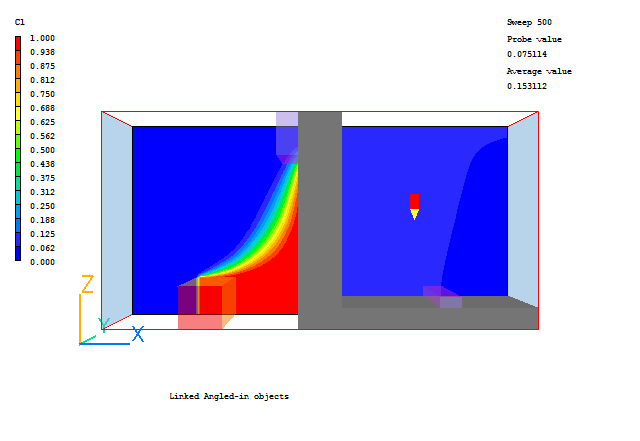
To check the temperatures at INTAKE and OUTLET, first select INTAKE the right-click and select 'Show results'. The Satellite command prompt will open showing the sums of sources for the INTAKE object.
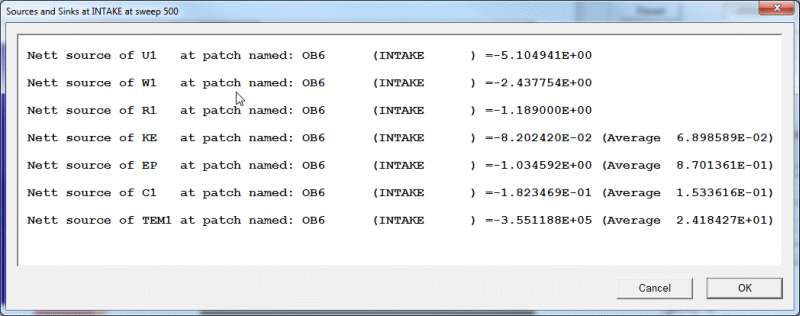
Now do the same for OUTLET.
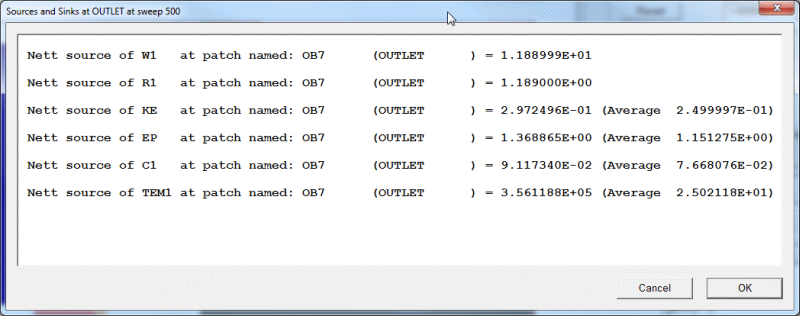
The mass flows (Nett source of R1, in kg/s) are equal and opposite, as expected. The energy sources (Nett source of TEM1 in W) are also opposite and the source at OUTLET is 1000W greater. The average temperature is slightly higher.
Looking at the C1 sources, the average C1 at OUTLET is half that at INTAKE.
In the PHOENICS-VR environment, click on 'Save as a case', make a new folder called 'ANG-IN ' (e.g.) and save as 'CASE3' (e.g.). Return to the VR-Editor by clicking 'Run' - 'Pre-processor' - 'GUI Pre-processor'.